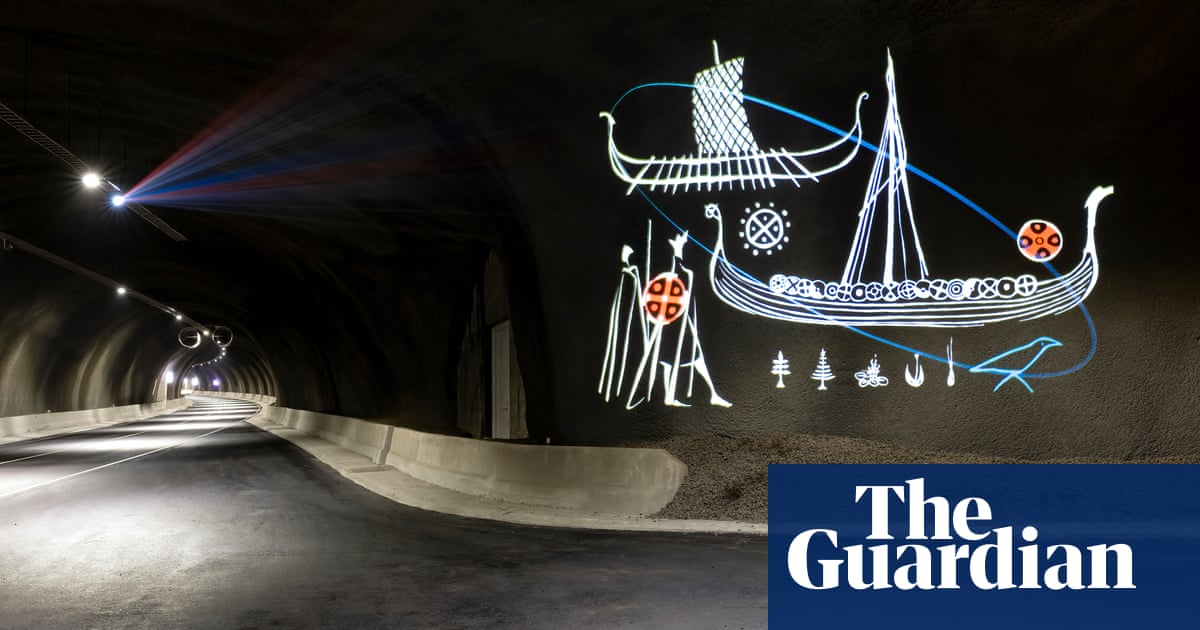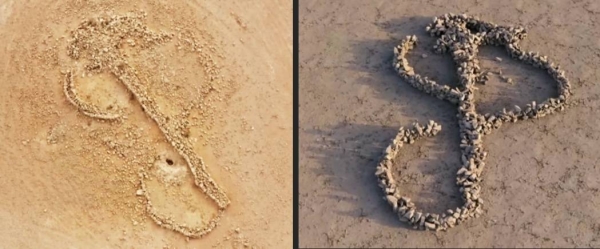
‘This is bigger than going from A to B,” says Edward Fuglø. “This is a route into another world.” Fuglø is a Faroe Islands artist who has created the paintings decorating the arching interior of a new tunnel snaking beneath the north Atlantic. Glowing, stylised human figures, many wearing Viking helmets and carrying spears, loom with a 3D intensity from the steely grey walls around me. The figures are accompanied by longships, mythic enchanted horses, cattle, birds and depictions of ancient stone ruins.
Using the latest Japanese projector technology, the 10 images – each several metres high and produced from Fuglø’s originals – are as bright as neon, and represent fantastical creatures and characters from Faroese legend. “Inside the tunnel we are dry,” Fuglø muses, “but we have the sense of the weight of the ocean above us. And we are crossing between very different islands; places with their own distinct identities, even in a place as small as the Faroes.”
I was taken through the tunnel for the first time 18 months ago, when construction was half-finished. The sound of water trickling from the bedrock above made an eerie soundtrack to the stygian gloom of the rock face, raw and jagged; a place of monstrous shadows created by the incremental dynamiting of small sections of the basalt. My guide was Teitur Samuelsen, the tunnel company CEO, who has overseen this giant infrastructure project. Aiming his torch upwards, he told me to hold out a cupped hand and collect some of the water dripping on to our heads. “Taste it!” he laughed. “It’s fresh, it’s not seawater. We’re more than 150 metres below the seabed – this comes from the bedrock. It’s not a sign that the tunnel roof is leaking.”
The newly opened link is 6∙5 miles long and connects Streymoy, the main Faroes island and home to the capital Tórshavn with its 20,000 strong population, and Sandoy, a small island where just 1,200 people live. Driving through the finished tunnel takes about 10 minutes. And for those who had only ever reached Sandoy on the little ferry that would buzz back and forth between the islands in (almost) all weathers, it’s a strange new sensation.
As a frequent visitor to the Faroes, which are part of the Kingdom of Denmark, I miss the heartbeat throb of the ship’s engines, the resounding clunk of the stern doors closing and the heady scent of marine diesel and salt spray. The voyage was short, just over half an hour, but spectacular – from the views of the smaller islands of Hestur and Koltur to the approaching cliffs of Sandoy. In winter, these often disappeared within a veil of spume and spray. Even in summer, they could be cloaked in a lowering sea-mist. The residents of Sandoy, however, see the tunnel as a lifeline, removing their dependency on the ferry.
The romance of the crossing may be gone, but driving through the new tunnel is quite an experience. Alongside Fuglø’s vivid artworks, the tunnel has its own soundscape, an original composition by Sunleif Rasmussen. Tuning the car radio to 100 FM, I find myself immersed in a spectral meditation that draws on sounds he experienced on his own early visit to the construction site. The dreamy electro-acoustic rhythms somehow amplify the thrumming of the car tyres, reinforcing the idea that I am heading into another dimension.
The new tunnel sets out from the tiny port of Gamlarætt, not far from Tórshavn. It is the second stage in an ambitious €360m project, which in December 2020 saw a similar link connect Streymoy with its eastern neighbour Eysturoy. As it nears Eysturoy, the tunnel splits left and right allowing drivers to emerge on to two different sides of the island. This three-way connection led to the world’s first underwater roundabout, which Samuelsen decided to turn into a visual centrepiece.
Inspired by the giant arc lights used to illuminate the excavations, he commissioned the veteran Faroese sculptor Tróndur Patursson to come up with a permanent installation. The result involves colourful lighting and a massive circle of life-sized steel figures that encircle the roundabout as if holding hands. The design is based upon the Faroes’ unique national “ring dance”, in which hundreds of people perform rhythmic side-to-side-movements, with new dancers free to join the chain at any point.
“We never suspected that the Eysturoy tunnel would cause such a stir,” says Samuelsen. “Many tourists include a journey through the tunnel as one of their must-see experiences in Faroes. They call it ‘the jellyfish roundabout’, because of its shape and the eerie underwater effect of the coloured ceiling lights. We felt that we had to produce something equally artistic for the latest tunnel.”
Emerging on to Sandoy by car for the first time, I am suddenly in a gentle green valley exactly halfway between the principal villages of Skópun and Sandur. The tunnel itself blends smoothly into the hillside adding to the sense of it being a secretive portal, and for those of us used to the more gradual arrival by sea, there is a sense of surprise at reaching here so quickly and effortlessly.
Sandoy residents seem universally pleased by the tunnel. Sproti Úr Dímun is 18, and plays for the professional football team in Sandur. “I’m studying in Tórshavn,” he says. “So travelling back and forth five or six nights a week on the ferry for training could take as much as five hours each day. It’s so much easier now – although the ferry was also a very sociable experience where you would talk to friends and perhaps play cards. I’ll miss that.”
Fuglø is struck by the pace of change in the Faroes in the last decade or so. “These tunnels have changed our lives,” he says. “My grandmother lived on another island and would sometimes take three days to get to Tórshavn by rowing boat, stopping to stay at farmhouses en route and waiting for the right tide and weather. She would never believe the speed at which we do things now. Our relationship with this rugged landscape is being tamed.”
Fuglø is keenly aware of the complex history of these islands, and the folk traditions that continue to play a part in everyday life, whether it be chain dances, or everyone knowing which island their grandparents came from. In his tunnel paintings, which he says were partially inspired by the idea of ancient man making marks on the walls of their caves, he has included numerous coloured birds. These are a reference to Diðrikur, who was born on Sandoy in 1802. An uneducated farmhand, Diðrikur produced colourful paintings of Faroese birds on scraps of packaging paper.
His simple, emblematic silhouettes of ducks, geese and delicately shaded moon doves now hang in the national gallery, the oldest known examples of Faroes figurative art. Some 150 metres beneath the Atlantic, Fuglø’s modern counterparts now perch like Diðrikur’s birds in these miraculous tunnels that look both to the past and the future.












